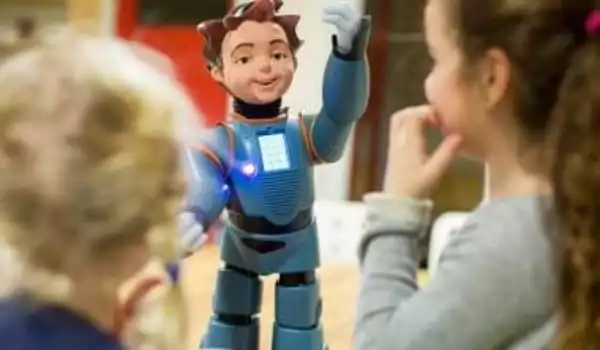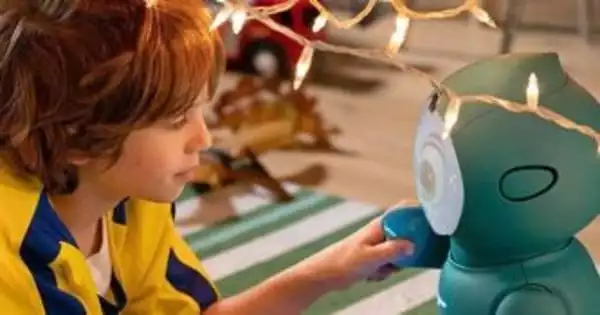A social robot is a self-aware robot that interacts and communicates with people or other autonomous physical agents by adhering to social behaviors and rules specific to its job. Researchers have looked into how users interact with a robot companion. Various models are presented in the literature to address this issue. A framework that models both the causes and effects of engagement is one example: elements connected to the user’s nonverbal behavior, the task, and the emotive reactions of the companion to predict children’s level of participation.
A new UCLA study suggests that a visit from a human-controlled robot enhances medical interactions and supports a positive perspective among hospitalized youngsters. Social robots are robots that interact with humans and other robots in a socially acceptable manner, transmitting purpose in a human-perceptible manner, and are enabled to resolve goals with other agents, human or robot.
Robin is a social companion robot that stands about 4 feet tall and can move, communicate, and play with people while being controlled remotely by humans. At October 2020 to April 2021, specialists from UCLA Mattel Children’s Hospital’s Chase Child Life Program used Robin to perform hour-long video visits with young patients, comparing it to interactions with a regular tablet. Children and their parents were asked about their experiences at the end of the study period, and child life professionals provided input in a focus group. The transcript of the talk was then used by the researchers to identify recurring and prominent themes.
Our team has proved that a social companion robot can go beyond video conversations on a tablet to give us a more innovative and profound method to make the hospital less stressful. As the pandemic continues, our patients remain nervous and vulnerable in a variety of ways, so it’s vital that we be as creative as possible in order to make their experiences easier when they need our aid.
Justin Wagner
Ninety percent of parents who visited Robin said they were “very inclined” to request another visit, compared to 60% of parents whose children interacted with the tablet. Following a visit with Robin, children reported a 29 percent rise in positive affect (defined as the inclination to view the world in a good way, including emotions, relationships with others, and dealing with life’s problems) and a 33 percent decrease in negative affect. Children who visited a tablet reported a 43% fall in positive affect and a 33% decrease in negative affect.
Parents whose children had a visit from Robin reported no change in positive affect and a 75% decrease in negative affect. Parents whose children had a tablet visit reported a 16% rise in positive affect and no change in negative affect.
The research will be presented at the American Academy of Pediatrics’ (AAP) National Conference.

Child life professionals who oversaw Robin’s visits reported benefits such as improved intimacy and interaction during play, increased control over their hospital experience, and the building of a new, trusted connection.
“Our team has proved that a social companion robot can go beyond video conversations on a tablet to give us a more innovative and profound method to make the hospital less stressful,” said Justin Wagner, MD, senior author of the study and a pediatric surgeon at UCLA Mattel Children’s Hospital. “As the pandemic continues, our patients remain nervous and vulnerable in a variety of ways, so it’s vital that we be as creative as possible in order to make their experiences easier when they need our aid.”
“We witnessed a good impact on children, their families, and healthcare personnel,” Wagner adds. The data also implies that staff will gain from improved closeness with and concentration on the patient, higher staff engagement in social care, and relative ease in maintaining infection control policies. Justin Wagner, MD, is a pediatric surgeon at UCLA Mattel Children’s Hospital and the study’s senior author.
Some of the difficulties included a restricted amount of time for patient interactions and a learning curve for operating the robot. According to the researchers, incorporating this form of social robot into an inpatient pediatric multimodal care setting can help and benefit young patients.
The study also found that child life experts faced problems such as limited time for patient interactions and a learning curve for operating Robin. According to the authors, the research shows benefits for young patients and supports the use of a social robot like Robin in an inpatient pediatric multimodal care context.
The increasing use of more advanced social robots is one of several phenomena that are expected to contribute to the technological posthumanization of human societies, a process in which “a society comes to include members other than ‘natural’ biological human beings who, in one way or another, contribute to the society’s structures, dynamics, or meaning.” Social robots are increasingly being employed in healthcare settings, and new research has looked into their suitability as mental health interventions for youngsters.





